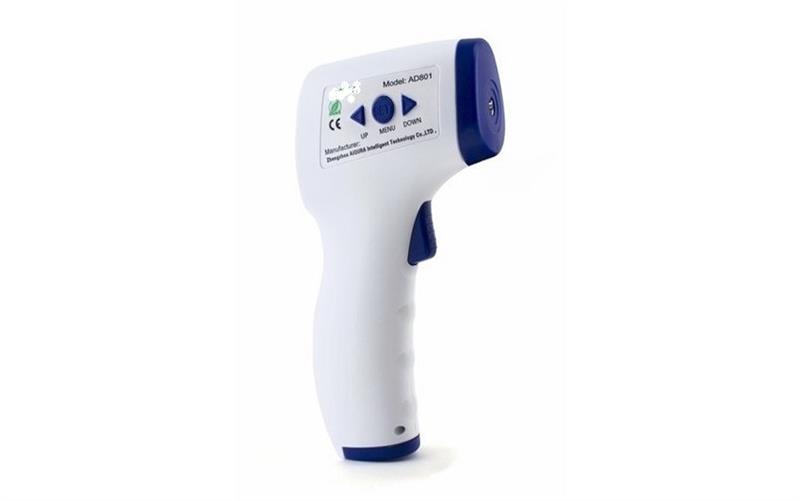
When it comes to measuring temperature, non-contact infrared forehead thermometers are revolutionary. They offer a rapid, secure, and effective method of detecting fever without making physical touch. These gadgets provide a dependable and easy-to-use solution for screenings at work, in healthcare settings, or at home. You can guarantee accurate readings and preserve the best possible health for both you and others around you by selecting the appropriate model and using it as directed.
Get a top-notch infrared thermometer now to enjoy the ease of use of contemporary medical technology!
Non-contact infrared forehead thermometers are now necessary equipment for homes, hospitals, and businesses in today's environment when ease and cleanliness are of the utmost importance. By eliminating the need for direct skin contact, these thermometers offer rapid and precise temperature readings while lowering the possibility of cross-contamination. Everything you need to know is included in this comprehensive guide, whether you're planning to invest in one or just want to understand how they operate.
How Do Non-Contact Infrared Forehead Thermometers Work?
The way infrared forehead thermometers work is by picking up infrared radiation that the forehead's skin emits. This energy is captured by the device and transformed into a temperature reading that is shown on the screen. The forehead is a trustworthy indicator of body temperature because it is a heavily vascularized region. For precise and reliable temperature readings, these thermometers use sophisticated sensors and algorithms.
Key Features:
- Infrared Technology: These thermometers provide safety and cleanliness by using infrared sensors to measure heat energy from the skin's surface without coming into direct touch with it.
- Fast Readings: Infrared forehead thermometers are very effective for both home and medical use because they produce readings in seconds as opposed to minutes for standard thermometers.
- Non-Invasive: Perfect for patients who need little disruption, elderly people, and newborns. These thermometers are particularly helpful for taking readings while you sleep because they don't require direct contact.
- Safe & Hygienic: It lowers the possibility of infection transmission, which makes it perfect for high-traffic locations like workplaces, schools, and hospitals.
- User-friendly features include memory storage to track previous readings, an easy-to-read digital display, and configurable settings to switch between measurement systems (Fahrenheit or Celsius).
- Multiple Measurement Modes: Some thermometers are adaptable for a range of applications because they have the ability to monitor body, surface, and room temperature.
- Fever Alert System: To help users act quickly, several versions have color-coded backlit displays or audible alarms that indicate fever levels.
- Energy-Efficient Design: The device is long-lasting and reasonably priced thanks to auto-shut-off features that assist preserve battery life.
Benefits of Using a Non-Contact Infrared Thermometer
- Safe and hygienic: Cross-contamination is more likely with traditional thermometers since they require direct touch. This problem is resolved by infrared thermometers, which make them safer to use communally in homes and healthcare settings.
- Quick and Convenient: Temperature checks may be completed quickly with only a single forehead scan, providing an instant reading. This is particularly helpful for screening big crowds of individuals and in emergency situations.
- Minimal Disturbance: You can take a child's temperature while they're asleep without waking them up because no physical contact is necessary. For parents and other caregivers, this makes it especially advantageous.
- Multipurpose Use: A lot of sophisticated models have extra modes to check the temperature of liquids (such as bath water or infant formula), objects, and even the surrounding air temperature.
- Accuracy and Reliability: These thermometers give readings that are on par with those of digital or conventional mercury thermometers when used properly. In order to preserve accuracy over time, several models additionally provide calibration features.
- Perfect for Group Screenings: These thermometers can be used in public spaces, schools, and businesses to rapidly and effectively screen a large number of people without making physical contact.
- Lessens Stress for Kids: Oral and underarm thermometers are sometimes disliked by kids. A stress-free experience is offered by a non-contact infrared thermometer.
- Operates in Low Light: Even in low light or at night, it is simple to read the temperature thanks to the illuminated digital display.
How to Use a Non-Contact Infrared Forehead Thermometer Correctly
To ensure accurate readings, follow these steps:
- Read the Manufacturer’s Instructions: Different brands and models may have specific usage guidelines. Always refer to the manual to understand how your particular thermometer works.
- Ensure the Forehead is Clean and Dry: Dirt, sweat, makeup, or lotion on the forehead can interfere with the infrared sensor’s accuracy. Wipe the area clean before taking a reading.
- Maintain Proper Distance: Most non-contact infrared thermometers require you to hold the device 1-3 cm from the forehead. Holding it too far or too close may affect the reading.
- Avoid External Heat Sources: Exposure to direct sunlight, air conditioning, heating vents, or other heat sources before measurement can lead to inaccurate readings. Allow the person to rest in a stable environment before taking their temperature.
- Use in a Stable Environment: Drastic temperature fluctuations in the surrounding environment can impact the accuracy of the readings. Ensure that the person and the thermometer have adjusted to room temperature before taking measurements.
- Check for Consistency: For the most reliable results, take multiple readings a few seconds apart and use the average reading as a reference.